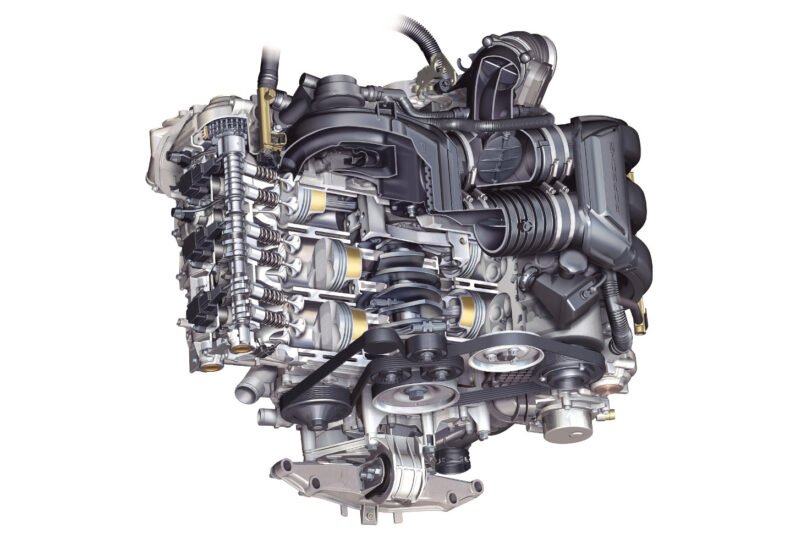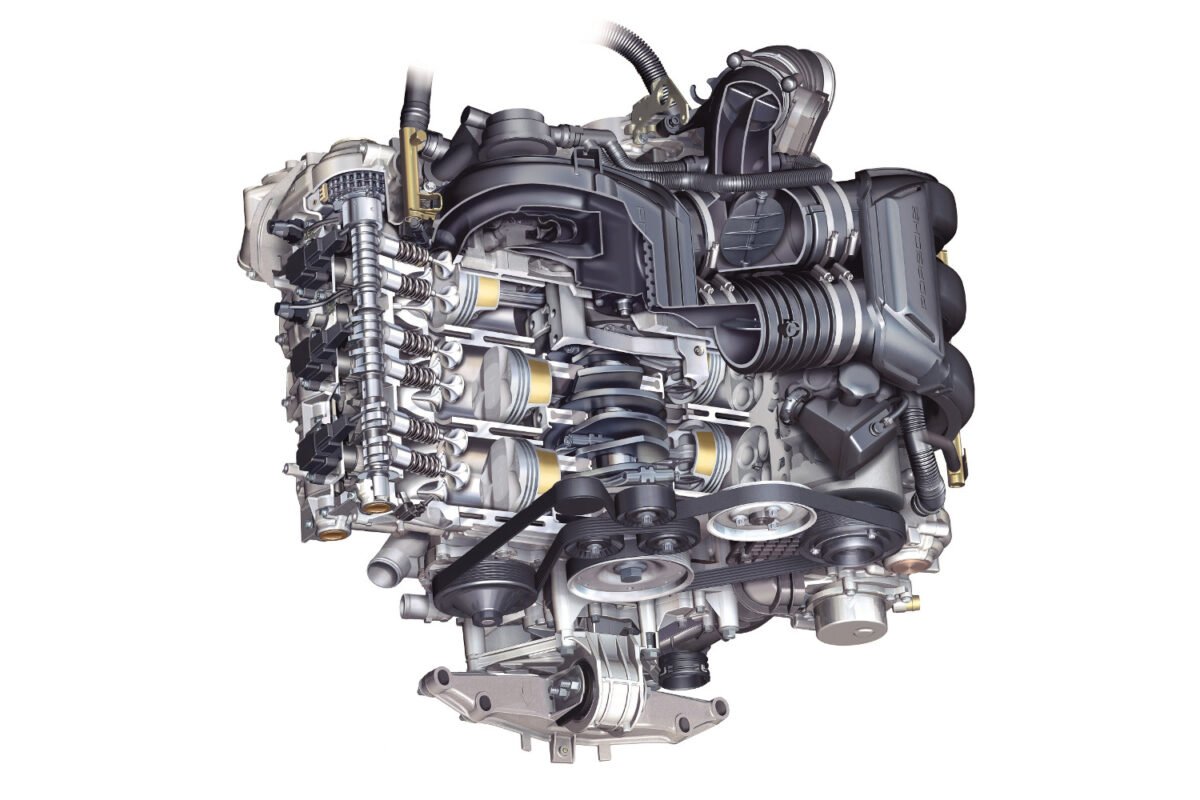
3.4-Litre – The 987 Cayman S Engine (2005)
The first ever 987-generation Porsche Cayman S was launched in 2005. It was powered by a six-cylinder 3.4-litre aluminium boxer engine. Let’s check some of the specs.
987 Porsche Cayman S Engine
The engine of the 987 Porsche Cayman S is both powerful and lightweight, with a low center of gravity. The two-piece block is die-cast in lightweight aluminum with integrated oil and water channels. This solution eliminates the need for drilling or external hoses, which are possible sources of failure.
A cross-flow cooling system channels coolant separately to each individual cylinder, so that all six cylinders operate within the same temperature range. Consistent temperatures reduce the chance of pre-ignition knocking, extend valve life, improve fuel economy, and lower emissions. And because the coolant channels are cast into the block, routine maintenance is significantly reduced.
An integrated dry-sump system ensures consistent lubrication. Oil is extracted by two scavenger pumps, one dedicated to each cylinder head. Narrow return lines de-foam the oil before it is collected in the integral sump. A third pump feeds the oil back to the lubrication points, starting the cycle anew. The result is consistent lubrication, even in sweeping high-speed turns.
VarioCam Plus
The engine of the Cayman S is equipped with the VarioCam Plus system that continually adjusts valve timing for optimum performance. Key benefits include increased power and torque at all engine speeds, smoother running, better fuel economy and fewer exhaust emissions.
The high voltage system with separate coils on each plug assure perfect ignition every time. With no central coil, there is no need for leads, a common source of electrical faults. All six coils are directly controlled by the engine management system, which can alter ignition timing if necessary.
Breathing is optimized by a twin-flow intake pipe, with valves that open and close at predefined engine speeds. A resonance pipe connecting the twin plenum chambers is used to alter the geometry within the manifold. The resulting vibration of the air molecules improves cylinder charging. The result of all this controlled breathing: higher torque at low rpm, a flatter torque curve and greater top-end power.

3.4-Litre Technical Specifications
- Six-cylinder aluminium boxer engine
- Water-cooled
- Engine block and cylinder heads made of aluminium
- Four overhead camshafts
- Four valves per cylinder
- Adjustment of valve timing on the intake camshaft and modification of valve lift (VarioCam Plus)
- Integrated dry sump lubrication
- Engine oil: 9.7 litres (2.13 Imp gals)
- Coolant: 22.3 litres (4.91 Imp gals)
- Bore: 96 mm (3.78″)
- Stroke: 78 mm (3.07″)
- Capacity: 3386 cm3
- Compression ratio: 11.1:1
- Engine output: 217 kW (295 bhp) at 6,250 rpm
- Maximum torque: 340 Nm (251 lb-ft) at 4,400-6,000 rpm
- Output per litre: 64.1 kW/87.2 bhp
- Max engine speed: 7,300 rpm
- Fuel grade: Premium plus (RON/MON 98/88), unleaded
- Electrical system: 12 V, 2100 W alternator, battery capacity 70 Ah
Check also
2006 Porsche Cayman S – 10 Fast Facts
You may also like
Latest Additions
- Porsche 911 (991.2) Option Codes (MY2017)
 Here are the Porsche 911 (991.2) option codes with descriptions from model year 2017. Options list may vary depending on the year/country
Here are the Porsche 911 (991.2) option codes with descriptions from model year 2017. Options list may vary depending on the year/country - Race Car: Porsche 935 (2019)
 The limited-edition 2019 Porsche 935 clubsport racer pays tribute to the legendary Porsche 935/78 Le Mans race car
The limited-edition 2019 Porsche 935 clubsport racer pays tribute to the legendary Porsche 935/78 Le Mans race car - Michelin Pilot Sport S 5 – Great for Wet Conditions
 Track tyres are usually designed to provide optimal grip in dry conditions. For those drivers who don’t mind a little rain, the Michelin Pilot Sport S 5 is a perfect option for prolonging the track-day season. Michelin Pilot Sport S 5 Jointly developed by Porsche and Michelin, the Michelin Pilot Sport S 5 is a
Track tyres are usually designed to provide optimal grip in dry conditions. For those drivers who don’t mind a little rain, the Michelin Pilot Sport S 5 is a perfect option for prolonging the track-day season. Michelin Pilot Sport S 5 Jointly developed by Porsche and Michelin, the Michelin Pilot Sport S 5 is a - What is the 2023 Porsche 911 Sport Classic?
 The 2023 Porsche 911 Sport Classic is a limited-edition model with distinctive design cues inspired by iconic 911 models from history
The 2023 Porsche 911 Sport Classic is a limited-edition model with distinctive design cues inspired by iconic 911 models from history - Guards Red 2025 Porsche 911 GT3
 Red is a sports car color. But is red a GT3 color? You might say "yes" after checking these images of a Guards Red 2025 Porsche 911 GT3
Red is a sports car color. But is red a GT3 color? You might say "yes" after checking these images of a Guards Red 2025 Porsche 911 GT3 - 2021 Porsche 911 GT3 Cup (992.1) Specs
 Here are the technical specifications of the 2021 Porsche 911 GT3 Cup (992.1) racing car based on the 992.1 generation of the Porsche 911
Here are the technical specifications of the 2021 Porsche 911 GT3 Cup (992.1) racing car based on the 992.1 generation of the Porsche 911 - Race Car: Porsche 911 GT3 RSR (2011)
 For the 2011 season, Porsche unveiled a new version of the Porsche 911 GT3 RSR with extensive modifications
For the 2011 season, Porsche unveiled a new version of the Porsche 911 GT3 RSR with extensive modifications - 2025 Porsche 911 Carrera Cabriolet PDK (992.2) Specs
 Here are the technical specifications of the 2025 Porsche 911 Carrera Cabriolet (992.2) with the PDK transmission
Here are the technical specifications of the 2025 Porsche 911 Carrera Cabriolet (992.2) with the PDK transmission - 2025 Porsche 911 Carrera Cabriolet – 10 Fast Facts
 The 992.2 generation Porsche 911 Carrera Cabriolet was introduced for the 2025 model year. Here are 10 fast facts about the 2025 Porsche 911 Carrera Cabriolet
The 992.2 generation Porsche 911 Carrera Cabriolet was introduced for the 2025 model year. Here are 10 fast facts about the 2025 Porsche 911 Carrera Cabriolet - Porsche Design Chronograph 911 Turbo S (2025)
 Inspired by the new 2026 Porsche 911 Turbo S, Porsche Design has released a new Chronograph 911 Turbo S watch
Inspired by the new 2026 Porsche 911 Turbo S, Porsche Design has released a new Chronograph 911 Turbo S watch
